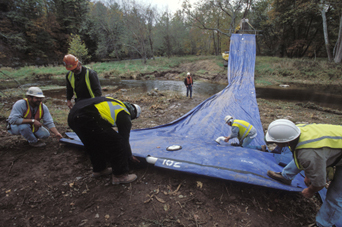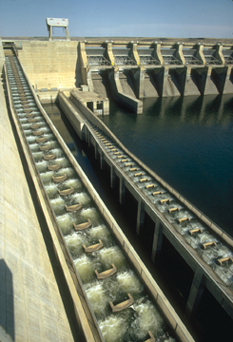 In the woods of Orange County, N.Y.,
the Cuddebackville Dam crosses a tributary of the Delaware River named the Neversink.
The Nature Conservancy calls it “one of the most pristine rivers in the
northeast.” But the dam, which has sat unused for half a century, breaks
up the river for its local inhabitants: a variety of species of fish, insects
and freshwater mussels, including the endangered dwarf wedgemussel.
In the woods of Orange County, N.Y.,
the Cuddebackville Dam crosses a tributary of the Delaware River named the Neversink.
The Nature Conservancy calls it “one of the most pristine rivers in the
northeast.” But the dam, which has sat unused for half a century, breaks
up the river for its local inhabitants: a variety of species of fish, insects
and freshwater mussels, including the endangered dwarf wedgemussel.Workers attempt to put in a temporary inflatable dam in preparation for removing the Cuddebackville Dam, located on the Neversink River in upstate New York. Courtesy of The Nature Conservancy.
Although the mussels are healthy, they are not found upstream; fish species also cannot cross the dam to spawn upstream. “You have [the mussels] locked in a really small area,” says the Nature Conservancy’s Emily Whitted, and their population, though healthy, is declining. And so, in partnership with the Army Corps of Engineers and local constituents, the environmental organization is leading a project to remove the dam.
Whitted says that this is the first time that a dam in New York State is being brought down for environmental reasons. It’s probably not going to be the last: Across the country, removing dams, whether for safety concerns or for restoring river habitat, is on the rise, with some surprising partnerships and results.
The National Inventory of Dams lists close to 77,000 dams across the United States, all of which are taller than 6 feet or hold at least 50 acre-feet of water (one acre-foot is the volume of water covering one acre to a depth of one foot). Maintained by the Army Corps of Engineers, with assistance from the Association of State Dam Safety Officials, the Federal Emergency Management Agency, and other state and federal agencies, the database lists dams mostly for safety reasons; if one breached or were deteriorating, lives and property downstream could be in danger.
The list does not count the many small dams erected on streams and rivulets over the past century or more. Farmers may have raised small berms to make impoundments for agricultural purposes, but more likely, industrial mills or other users that are long gone erected small dams. These structures may not be life-threatening, but they still could affect the environment downstream if they were to breach unexpectedly, and they certainly create a barrier to local wildlife, disrupting what was once the natural flow of a stream or river.
Elizabeth Brink of the International Rivers Network, based in Berkeley, Calif., estimates that 40 to 60 dams are removed across the nation every year, mostly small ones that fall under the radar of the federal database. Brink says that there is “definitely a trend” toward removing smaller dams, and that environmental organizations also have their eyes on the removal of much larger dams.
An important partner for many of these projects is the Army Corps of Engineers. Since the mid-1980s, Lonnie Mettler, an Army Corps engineer, has watched the culture of the institution subtly shift from building to maintaining dams. He says that merely suggesting removing a dam, once unheard of, was not as surprising in the organization by the mid-1990s.
Now the Army Corps generally acts as a consultant to a private or government partner that finances and shepherds a dam removal project to its completion. Doug Putnam, an Army Corps engineer who works on several dam projects in the Northwest, says that the main consideration for removing dams is a rule concerned entirely with aquatic ecosystem restoration, but the Army Corps also assesses technical feasibility, among other criteria.
For dams that produce electricity, for example, “a lot of projects have come up for relicensing, and a lot of them have filled with silt and aren’t working,” Putnam says. “The big trick there is how do you take it out without creating a problem?” Releasing silt downstream that contains contaminants, or that might change the river morphology in unexpected or unwanted ways, may be worse than keeping a dam in place.
“Often these dams were built for industrial purposes,” before controls were in place on many industrial contaminants that were released, says John Catena, a wildlife biologist who heads the Northeast Restoration Center of the National Oceanic and Atmospheric Administration (NOAA). But, Catena says, “there are ways to deal with that,” including dredging before removal.
Local residents may also raise aesthetic concerns, Catena says; surprisingly, some people may not want a dam removed because “they’re used to seeing a lake.” But other concerns may start to take precedence, from environmental concerns on the part of individuals or organizations to the federal perspective of getting fish to their spawning grounds.
 On
the lower Snake River in Washington, for example, which feeds into the Columbia
River and is a major highway for spawning salmon, the Army Corps recently completed
an assessment of four federally owned hydropower dams. At the behest of the
NOAA National Marine Fisheries Service, which tracks the status of endangered
and threatened species’ environments, the Army Corps looked at several
scenarios for the dams, from leaving them alone to their complete removal —
all with the welfare of Chinook, steelhead and other salmon in mind.
On
the lower Snake River in Washington, for example, which feeds into the Columbia
River and is a major highway for spawning salmon, the Army Corps recently completed
an assessment of four federally owned hydropower dams. At the behest of the
NOAA National Marine Fisheries Service, which tracks the status of endangered
and threatened species’ environments, the Army Corps looked at several
scenarios for the dams, from leaving them alone to their complete removal —
all with the welfare of Chinook, steelhead and other salmon in mind.A fish ladder at the Ice Harbor Dam on the lower Snake River, pictured here, helps salmon make their way upstream. Removing this and other Snake River dams remains too costly because of the economic and social impacts, but the removal of smaller dams is on the rise. Courtesy of the Army Corps of Engineers.
They found that removing the dams would lead to the loss of electricity generation amounting to $271 million a year over 100 years. The Army Corps also determined that the loss of agricultural water sources would have too high an impact on the local communities that relied on the river, affecting low-wage farmworkers and Native Americans. The final report recommended not breaching the dam, but instead improving the fish ladders (structures that allow fish to jump up the dams in steps) or continuing to ferry fish upstream in what are basically aquariums on wheels.
The decision created an uproar in local communities. Several groups, including Native American tribes that have treaty rights to Columbia River salmon, argued that fish ladders and trucking fish upstream are not effective methods for protecting endangered fish — certainly not as effective for spawning as a natural river environment. But Mettler, who managed the assessment, points out that even if the four federal dams were removed, there are several privately owned dams on the river that would continue to block fish from spawning upstream. However, he says, the federal dams’ status will be reviewed every three years or so, and their removal “is not off the table.”
In some ways, dam removal has never been more on the table. Catena says that when he joined NOAA’s restoration program just over a decade ago, “dam removals were not even a subject for discussion.” Then, after one of the first dam removals in the Northeast, the Edwards Dam in Maine about five years ago, interest escalated. “The trend is a tremendous increase in proposals coming in for dam removals and much more public interest in it,” he says. Now, NOAA is funding 54 such projects, totaling over $2.2 million, and Catena says that the program will probably double its dam removal projects in the next year.
In the meantime, the starting date for removal of the Cuddebackville Dam on New York’s Neversink River has been delayed a year. “It’s really complicated,” says the Nature Conservancy’s Whitted. “Usually you think that you stick a stick of dynamite in, and boom, you’re done,” she says.
But the two-part dam has tons of silt built up on one side, Whitted says, and the northeast half of the dam feeds a nearby canal that is important to the local community. Plus, when the dam is removed, the streambed must be allowed to dry out for regrading, boulders must be placed strategically for proper riverflow, and fish and mussels must be rescued from an area suddenly without water. So the Nature Conservancy, under consultation with the Army Corps, has decided to carve a fish ladder into the northeast side of Cuddebackville Dam, and bring down only the dam’s southwest portion.
“You have to deal with the whole system, and really, a lot of this hasn’t been done before,” Whitted says. “There’s an art to this.”

